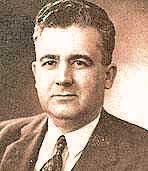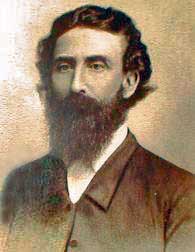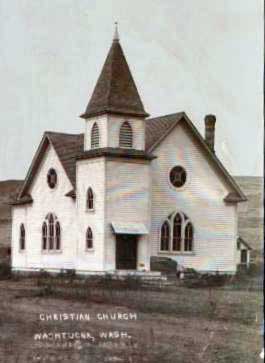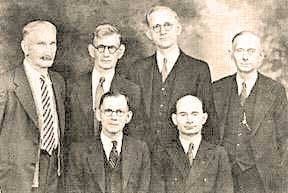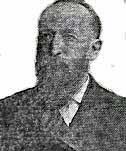 Churches of Christ & Christian Churches in the Pacific Northwest ADAMS COUNTY, WASHINGTON |
 by Charles Dailey College index |
Cunningham | Hatton | Lind | Othello | Ritzville | Washtucna
Next Chapter . . . Pioneer Menu . . . Search - - Oldest presented first.
Introduction to Washington State
Our Sources. The work of preaching simple New Testament Christianity began a few years later in Washington than Oregon. Conflict with Indian tribes was a more severe problem. The story of the Restoration in Washington has not been preserved as well as that of Oregon. One source of information is Washington-Northern Idaho Disciples written by Orval Douglas Peterson in 1945 and published by the Christian Board of Publication.
Orval D. Peterson The researcher may consult portions of Washington-Northern Idaho Disciples on-line.A second, but brief, source is Churches of Christ by John T. Brown published in 1904. In an article there written by F. Walden we read: "We have churches in nearly every county seat in the state, as well as in the smaller towns and villages and also in many rural districts."
Mr. Walden's entire article is now on-line and indexed to these pages.Below unfolds our ongoing effort to chronicle the Pioneer events of Restoration Churches in Washington State. Actually, the story begins while Washington is still a territory.
Thomas Franklin Campbell penned some significant words in his Pacific Christian Messenger that applied equally to Oregon and Washington:
He answered, essentially, that no more men were available. Trained workers were at a premium in both areas. The church was growing as fast as leadership could be found.DEMAND FOR PREACHERS
From almost every part of the State and of Washington Territory, letters are coming in asking for preachers. The Macedonian cry for help comes up from all quarters.
The following churches also existed, but data is not available for them: Alamira, Anacortes, Badger, Bickleton, Carson, Clinton, Cora, Deep Creek Falls, Eagle Lake, Endicott, Enterprise, Ewartsville, Eureka, Everett, Fletcher, Four Mile, Griffiths, Guy, Ilia, Kent, Luna, Lowell, Malagada, Meadow, Methow, Milan, Moro, Mt. Vernon, North Star, Paha, Pasco, Prairie Chapel, Pleasant Flat, Ruby City, Sackman, Sand Springs, Sumas, Stephens, Silver Creek, Thornton, Tracerton, Toledo, Wenatchee, Wilson Creek, White Lake, and Wallula.
Very little about the history of Adams County would have been available without the diligent research of Karin Clinesmith, Research Librarian at the Ritzville Public Library. Karin is also a Board Member of the Adams County Historical Society.
Ritzville Yahoo Map At the Highway Intersections.
Ritzville, in the center of a rich wheat-growing area, was named for an early pioneer land owner, Philip Ritz. The town became the largest initial wheat-shipping point in the United States.
There is no local memory of a Christian Church in Ritzville. However, W. F. Newland wrote from there early 1888 saying, "A few of us (about 15) meet every Lord's day, in Ritzville, to break the loaf. We expect to organize a church there this spring."
Mr. Newland, a Kentuckian, and his brother Andrew, homesteaded southwest of Ritzville in 1883. He married Helen Roe and moved to the Lind area in 1895. For some years, he served as the County Assessor of Adams County.
The church existed by 1891 because G. M. Weimer of Ellensburg held a meeting in the summer and conversions and other additions brought the number of members to 28. He also ordained J. C. Adams and N. H. McDonald to the ministry while there. There is no further word of these men.
William R. Cunningham In 1902 the building was located at the intersection of West First and South Adams. It was at the north corner of the intersection, the streets being layed at a slant to due north. By 1922, it has been removed and a service station was on the property.
The church history of Ritzville must contain the story of William Randolph Cunningham (1834 - 1919) who moved to the area from Kentucky. He had studied at Alexander Campbell's Bethany College in what is now West Virginia.
In 1870, he began preaching among the Churches of Christ, coming to Ritzville in 1889. He obtained property near Scott's Station and set up the town of Cunningham, 33 miles west of Ritzville. He named the community after himself and Cunningham Station that was near his home in Bourbon County, Kentucky. The Cunningham family residence remained in Ritzville.
See our separate profile of William Randolph Cunningham.
The minister in 1904 was E. E. Davidson, born in Ohio and raised in Missouri. At eighteen, he went to Nebraska where he was taught the faith of the gospel by J. W. Wilson. He confessed Christ and was baptized at South McAlester, Indian Territory in 1893. He commenced preaching three years later. Among his earliest converts to Christ were his mother and his sister.
E. E. Davidson Sometime following these events, he moved to Ritzville.
This farming community was named after a Palouse Indian chief. The first store was opened in 1894. We cannot tell when the church began, but historian Orval Peterson shows it on his list of churches for 1897. The building was erected in 1903. Eventually it was sold to the Grange, that sale taking place in 1938.
Washtucna Christian Church The Morgan families played a decisive role in the establishing of Christian Churches in Adams County and this one was probably launched by William Woodford Morgan, son of Thomas McBride Morgan.
Lind Yahoo Map
As the farming town of Lind developed, the railroad came and the sagebrush gave way to productive land. The Lind Leader of 1903 urged the residents to put straw on the main roads to fight the mud.
The Christian Church was established there, probably through the influence of William Franklin Newland, mentioned above. The year was about 1895. Thomas McBride Morgan was also involved in the early days of the Lind congregation. His family had settled about 14 miles south of town and had established a church in their own neighborhood. See next entry.
There is a profile of T. M. Morgan.Hatton Yahoo Map
An earlier name for Hatton was Twin Wells. It was platted in 1901, but had population at an earlier date. In those years, it had a railroad station and siding and grain was shipped from Hatton. That is no longer true today. In its heyday, about 100 children attended school, while today the town itself numbers about 85 residents.
The sons of Thomas McBride Morgan:
Back: Andrew, Vernon, D. Lloyd and Lester
Front: Simon and Charles
These men had a strong Christian
influence on early Adams County.Living in the Sand Hills neighborhood east of town were several members of the Thomas McBride Morgan family. After years of traveling and preaching in Oregon and Washington, T. M. settled here. It is likely that T. M. and Rachel Morgan; Vernon and Laura Morgan; and Simon and Minnie Elizabeth Morgan attended the Hatton or Delight Church.
For more about T. M. Morgan, see our separate profile of his life and family.Another family living near them was Samuel and Rena Moore Allen. Mrs. Allen was a member of the Christian Church.
The Christian Church began near this village around 1892. It was out of town to the east in the Delight district at the intersection of State Highways 26 and 21. While the Delight community is now closer to Lind than Hatton, the road to Lind may not have been complete and Hatton was easier to reach.
An entry in the listing of cemeteries for Adams County tells of the cemetery in the yard of the Christian Church that was 1 3/4 miles north of the Levi Sutton place. That may be the present Delight Cemetery. Levi Sutton is buried in the Michigan Prairie Cemetery east of Hatton and near the Morgan holdings in Sand Hills.
In 1894 W. R. Cunningham held a meeting at the Delight Schoolhouse and reported the number of believers had risen from 12 to 58. The group meeting at the Delight Schoolhouse may have been the Hatton Church and later built a building at the intersection.
An article in the Northwest Tribune of March 9, 1895 reports that a "meeting house will be built at Delight, Adams County, Wn." The article relates to Christian Churches in Washington.
One article produced in Adams County that describes burials in fields says the Christian Church was removed before 1915.
Cunningham Yahoo Map
The beginnings of Cunningham have been discussed above near the photo of William R. Cunningham. John W. Damon (1853-1902) and his wife Arilla Jane (1862-1918) were early settlers here and helped to establish the Christian Church. They arrived by the Northern Pacific Railroad from Ottumwa, Iowa in 1899, along with her parents, the Shillings. John, like all of the ministers of his day, farmed for a living and preached at the Christian Church on the Lord's Day. Their farm was about 3.5 miles north and west of Cunningham. John died three years after his arrival, but Arilla Jane outlived him another 14 years.
John W. Damon
They are buried in the Cunningham Cemetery along with their son Clarence. Grandsons Ralph Damon and Louis Street are also buried there. Arilla Jane's parents were John and Eliza Shilling and they, too, are buried in the Cunningham Cemetery.
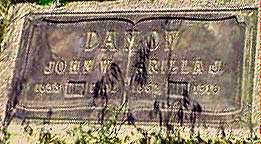
DAMON JOHN W. ARILLA J.
1853 - 1902 1862 - 1916The cemetery is overrun with wild wheat and ground animal holes. Fire has destroyed the wooden grave markers, but the markers of granite and other stone still stand. The shadows of wild wheat can be seen on the Damon headstone. Also, instead of hyphens, the dates are separated by open books - The Bible.
The Cunningham Cemetery is listed I-5. Our information about the Damon family is based on the records of Patricia Ann Damon Butterfield.
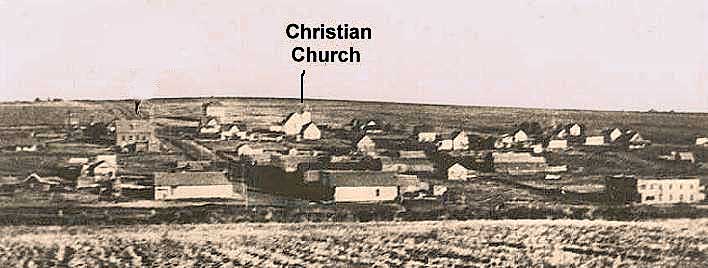 |
The building was at the intersection of 4th East and 4th North. Photo courtesy of Tom Simpson |
In a brief autobiography, W. R. Cunningham says he preached every Lord's Day at Cunningham during the later years of his life. This probably began in 1902 following the death of John Damon. He no doubt reached Cunningham by train from Ritzville.The town reached its peak in 1913 with an estimated population of 500. Today there are just a few scattered homes left in the village of Cunningham and the Christian Church has long been forgotten.
Othello Yahoo Map
The name for the community was drawn from the five-act tragedy by William Shakespeare.

The Othello Christian Church circa 1915 The congregation was established in 1913 during a tabernacle meeting conducted by Francis Ware. The tabernacle had straw on the floor and a canvas roof. The building of the Christian Church had earlier served as a country church building east of Othello, near Cunningham. In the photo, it is located at the corner of Fourth and Spruce. The old High School can be seen in the background.
We do not have a firm date for this photo, but the lack of utilities and autos places it early in the 1900's.
Among the early ministers was Rebecca Walton (Mrs. W. R.) Cunningham. She probably traveled by train to Othello while her husband used a different train to reach the village of Cunningham each Sunday.
To DOCHS 2/02
Another congregation in Adams County before 1900 was Paha.
Next Chapter: Asotin County or back to Pioneer Menu

